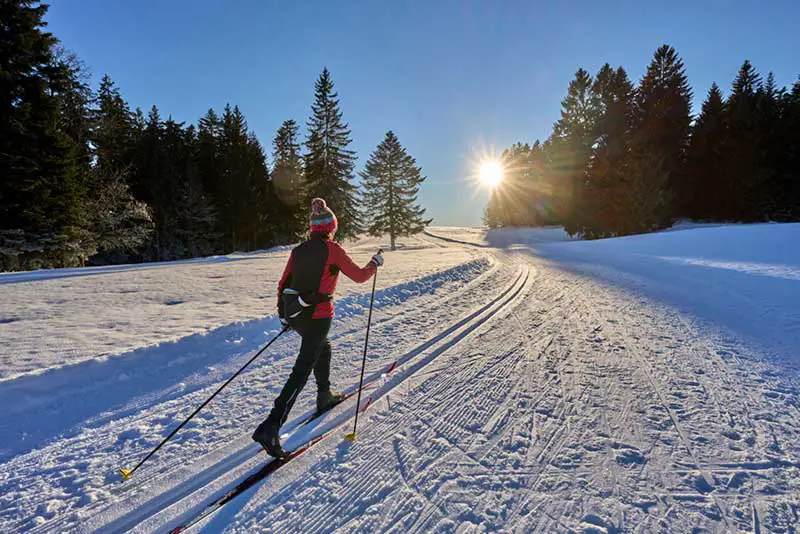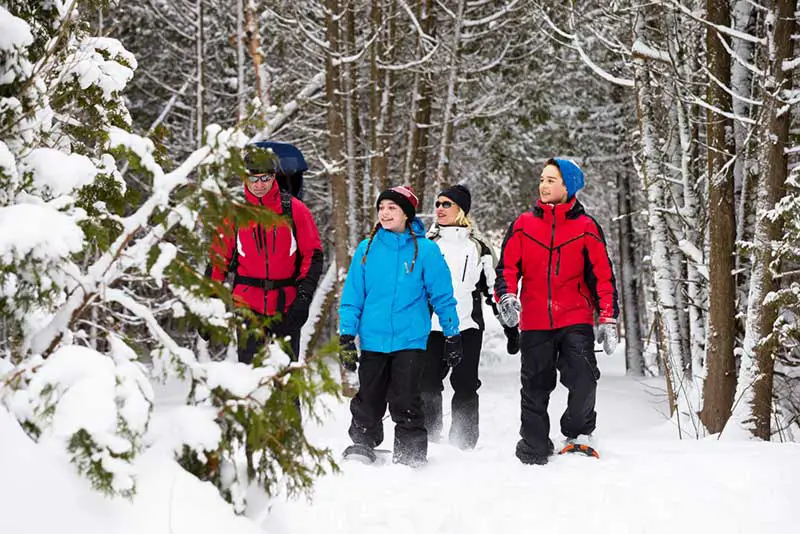Find your NH Vacation Ideas
Learn about visiting New Hampshire
10 Family-Friendly Hikes in the White Mountains of New Hampshire
Hiking is on a spectrum: it can be a light stroll through the woods or [...]
Cross-country (XC) skiing and snowshoeing are two of the most popular winter activities. Their popularity has grown even more since 2020. If you’re wondering what the difference is between each sport and which is better, we’ve laid out all the details below. Keep reading to learn more!
Cross-Country Skiing
Also called nordic skiing, cross-country skiing is very different from downhill skiing. Rather than skiing down steep terrain, cross-country skiers typically move over flat and sloping ground. They use their entire bodies to push themselves through the snow. When you cross-country ski, your feet are only attached to your skis by the toes. To propel yourself forward, you have to move your heels up and down and push off the ground using poles.
Cross-Country Skiing with a Family
Cross-country skiing is a fantastic way to enjoy the outdoors with your family this winter. If you’re all beginners, start by taking a lesson together so that you can get a feel for the skis and necessary movements. Make sure you stay on beginner trails and keep a map of the area with you in case you decide to go on your own.
If you have kids under the age of five, they’ll have a hard time using the skis, so cross-country skiing isn’t ideal for them unless you consider yourself enough of an expert to be able to pull them along in a trailer or sled.

What You Need to Go Cross-Country Skiing
Much of the gear you need to go cross-country skiing is similar to what you should have when downhill skiing. Here’s a list of the essentials:
- Cross-country skis: Cross-country skis are skinnier than downhill skis. They also don’t have a sharp edge.
- Cross-country ski boots. Similar to cross-country skis, the boots you use when you go cross-country skiing differ from downhill ski boots. Cross-country ski boots are much lighter and usually have a zipper rather than buckles.
- Cross-country ski poles: Again, cross-country ski poles are slightly different from downhill ski poles. They tend to be longer, which helps you push yourself forward as you skate over flat surfaces.
- Warm hat. A hat will keep you warm as you ski. Some people also use warm headbands that cover their ears for warmer days.
- Insulated mittens. You don’t want to use your everyday mittens to go cross-country skiing, as they’ll get cold quickly. Opt for the same insulated mittens or gloves you would use to go downhill skiing.
- Fleece-lined pants. Warm tights or pants are essential for staying warm while cross-country skiing. Snowpants tend to be too bulky for cross-country skiing.
- Plenty of layers. Depending on how cold it is outside, you have to layer up when you go cross-country skiing! Make sure to wear a base layer and plenty of warm clothes. You should also try to avoid cotton. Instead, opt for things made of wool or moisture-wicking fabric, especially for your base layer and socks.
- Sports glasses. Glasses designed for sports are great for keeping your eyes free from snow.
If you’re planning to go on longer trails or do backcountry cross-country skiing, you should also bring a ski or day pack, a navigation device, a multi-tool, and extra food and water.
Cross-Country Skiing Cost
Cross-country skiing is cheaper than downhill skiing. That’s because nordic ski season passes tend to be less expensive than downhill ski tickets. The equipment also typically costs less.
If it’s your first time going cross-country skiing, we recommend renting skis first to make sure it’s something you love. It’s also a great idea for families. Most nordic ski centers rent equipment together, meaning you’ll get boots, skis, and poles for one price. Depending on where you go, you can typically get rentals and a day pass for anywhere between $35 to $100 per person.
If you decide to buy equipment for cross-country skiing, your biggest purchase will be the skis, boots, bindings, and poles. Many places will sell these to you in a packaged bundle, and you can expect to spend anywhere from $700 to $1500 in total.
The Best Conditions for Cross-Country Skiing
The ideal conditions for cross-country skiing are dry, medium- to light-density snow with good coverage. Most people prefer to go nordic skiing in temperatures between 20 and 30 degrees Fahrenheit, but people that live in colder climates may be comfortable at lower temperatures. Hitting the trails in the later hours of the morning is also the best time of day. It allows groomers to smooth out the trails and means the snow will have softened a bit after firming up overnight.
Snowshoeing
Snowshoeing is an outdoor winter activity that is similar to hiking but involves strapping a specialized snowshoe onto your feet to make walking through snow easier. You can snowshoe on lots of different terrain like national parks or forests, mountains, and dedicated snowshoe trails. The skills required to snowshoe are minimal, and most people can pick it up fairly quickly.
Snowshoeing with Family
Snowshoeing is a great winter activity that you can do with the whole family. It’s quite easy to pick up and doesn’t require prior knowledge or experience. The best thing about snowshoeing is that you can do it with young children. As long as your kids can walk, they can snowshoe! Most snowshoes made for kids are meant for toddlers who are at least three years old. But as long as your child can walk, they can try out snowshoeing!

What You Need to Go Snowshoeing
Some of the basic gear you need for snowshoeing is similar to what you need for cross-country skiing. Still, there are some differences. Here’s a list of snowshoeing essentials:
- Snowshoes: The most important piece of equipment when you go snowshoeing is, of course, the snowshoes! Make sure to purchase or rent snowshoes that are right for your weight and foot size. Some snowshoes are also designed to be used on different terrains. Make sure to ask questions so that you know exactly what you’re buying.
- You don’t need to use poles when you go snowshoeing, but they do provide extra stability.
- Waterproof winter boots. Snowshoes use an adjustable strap to lock your feet in, which means they’ll fit just about any shoe. We recommend using a waterproof winter boot to keep your feet warm and withstand the snow.
- Warm hat and gloves. Make sure to wear a warm hat as you snowshoe and use warm gloves. Again, we recommend insulated gloves to keep your hands extra warm.
- Snow pants. Snowshoers can easily wear snow pants without worrying about them being too bulky – and they should! Snow pants are the best option to keep you warm all day long.
- Plenty of layers. Depending on how cold it is outside, you have to layer up when you go snowshoeing! Make sure to wear a base layer and plenty of warm clothes. You should also try to avoid cotton. Instead, opt for things made of wool or moisture-wicking fabric, especially for your base layer and socks.
- Sunglasses and sunscreen. If you’re snowshoeing on a sunshiney bluebird day, you need to protect yourself against the sun. Make sure to wear sunglasses and apply sunscreen if it’s sunny outside.
Similar to nordic skiing, if you’re planning to snowshoe on longer trails or do backcountry winter hiking, you should also carry a day pack, a navigation device, a multi-tool, and extra food and water.
Snowshoeing Cost
Snowshoeing is one of the most affordable winter activities. All you need is snowshoes and the appropriate warm layers. Since most people already have snow pants and winter boots, they can easily rent snowshoes.
If you’re looking to buy a pair of snowshoes, you can expect to pay anywhere from $100 to $500.
The Best Conditions for Snowshoeing
You’ll want to avoid snowshoeing on days where there is poor visibility, wet or rainy weather, or extremely cold temperatures. The best weather for snowshoeing includes clear skies and moderate winter temperatures – anywhere from 15 to 30 degrees Fahrenheit. You can snowshoe on almost any snow, but most people prefer hard, packed snow or freshly fallen powder.
It’s always important to look at the weather before you go snowshoeing, especially if you plan to take a long trip. If you’re going to be snowshoeing in higher altitudes, being aware of avalanche safety measures is also essential.
Is Cross-Country Skiing or Snowshoeing Better Families?
Both cross-country skiing and snowshoeing are great winter activities you can do with the whole family. Here is a quick breakdown of the two cold weather sports:
Cross-Country Skiing | Snowshoeing | |
Good for kids? | Better for kids over the age of 5. If you’re an expert, you can pull your child behind you on a trailer. | Any walking toddler can try snowshoeing! |
Cost | Rent: $35 - $100 per person Buy: $700 - $1,500 | Rent: $20 - $50 per person Buy: $100 - $500 |
Best Conditions | Dry, medium- to light-density snow with good coverage. Temperatures between 20 and 30 degrees Fahrenheit. | Clear days with temperatures between 15 and 30 degrees Fahrenheit. Hard, packed snow or freshly fallen powder is best. |
Gear | XC skis, XC poles, XC boots, insulated gloves/mittens, a hat, sports glasses, fleece-lined tights | Snowshoes, poles (optional), good winter boots, snow pants, warm layers, sunglasses, hat, gloves |
New Hampshire: Your Destination for Family Winter Adventures
New Hampshire is a winter destination for families across America. It has a variety of cross-country ski and snowshoe trails that you can take advantage of this winter. At New Hampshire Vacation Ideas, we aim to help people and their families have the best New Hampshire vacation they can. Check out our website to keep planning your perfect New England cross-country ski trip.

